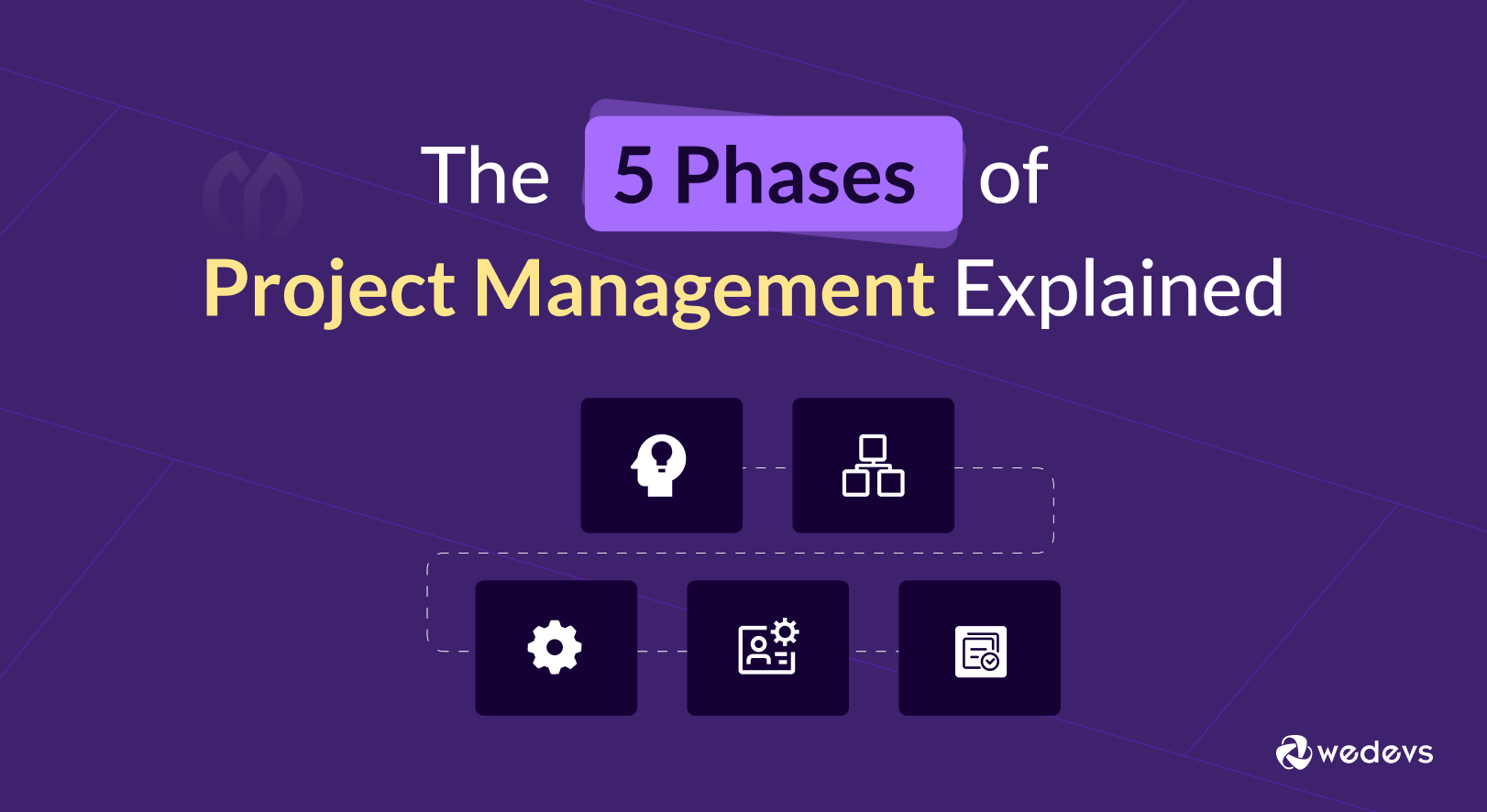
5 Phases of Project Management Explained
Project managers often face problems like project delays, miss communications, wrong analyses of a project's scope, etc. You can't get a full-on success rate, but with each failure, you learn and mitigate the risks.
Also, if you are well aware of the proceeding situations of a project, and how each phase of a project works, it's possible to increase your success ratio.
There are 5 phases of project management, and as a project manager, your job is to master them all from scratch to final execution.
In this article, we are going to break down these project management phases for you.
What are the 5 Phases of Project Management

Every project has a life cycle. This consists of four or five steps that you can usually name as phases of project management. Project management phases follow a similar pattern regardless of the size or type of a project. Here are they –
- Project Initiation
- Project Planning
- Project Execution
- Project Monitoring and controlling
- Project Closing
1. Project Initiation or Conception
The first thing of a project is its conceptualization and initiation. As a project manager, you need to create a primary picture for a specific project on how to start and how to progress to the next steps one after another.
In the initiation stage, you need to gather your ideas and turn them into a business plan, set goals, define scope, and project charters, and define people who are responsible for a project's success or failure aka stakeholders.
The project initiation phase must accomplish the following tasks –
Defining the project objectives
The first question you should ask yourself, and the stakeholders is – ‘what do you want to achieve with this project?'
For example, you are working for a WordPress plugin developer company. As a project manager, you want to initiate a project for a new pricing page. In this case, you must find out why your current pricing page isn't working and what kind of return you are expecting from a newly designed pricing page.
Set your scope
Seeing your project boundaries long before you start working on it, that's all about setting your scope. In this stage, you create the initials of your project goals, deliverables, deadlines, etc to understand how far you want and can go.
Also, this stage includes funding and budgetary aspects, and the overall time of the projects.
Finalizing the stakeholders and defining their roles
Stakeholders are the people who will be closely connected and liable for the progress and outcomes of the project. Some of the common project stakeholders are – sponsors, project managers, project team members, clients, end users, internal stakeholders, etc.
As a project manager, you are going to define each stakeholder's roles and responsibilities.
Possible obstacles
In the project initiation stage, it's possible to assume and list all the obstacles/ risks you may face in the coming days and create backups and plan B.
Risk management is a big task that involves risk assumptions, brainstorming, gathering resources to handle the risks, assessment, prioritizing, etc.
Also Read: How to Manage Risk in Project Management: Effective Tips for Project Success
2. Project Planning

Project planning is the immediate step after the project initiation stage. It includes the broader definitions of project goals, from ‘how to control and monitor the project' to project completion.
There are two most popular project planning approaches amongst project managers –
a. The SMART method. It means your planning should be specific, measurable, attainable, realistic, and timely.
b. The CLEAR method. It suggests a collaborative, limited, emotional, appreciable, and refinable work process.
While working on it, you should combine the two approaches for better results.
In the planning stage, you could write down and define the complete roadmap of your project. Here's how it goes –
- Creating a project management plan
- Developing a work breakdown structure (WBS)
- Estimating resources and project duration
- Creating a risk management strategy
The main accomplishment of this stage is to pin down all the steps of the initiation phase and elaborate on them. So your task would be developing an in-depth plan for project execution, monitoring, and proper controlling.
In this stage, you need to gather all of your team members and assign them specific tasks. For example, for each of your tasks, you can one or multiple team members and set a deadline to complete the task.
Also, you can establish a proper communication channel between the team members and stakeholders. Messaging tools like Slack would be a smart option in such cases.
3. Project Execution
Now, you have your plan ready. It's time to go to work. So, this stage includes launching your project and executing the tasks bit by bit, producing project deliverables until final accomplishment. In other words, this phase is all about turning your plan into action.
Hence, as a project manager, you are going to establish a robust workflow that will help your team members work flawlessly, communicate with precision and put their effort to reach the project goal. This includes the following –
- Look closely at the team workflow
- Managing your budget properly
- Communicating with your stakeholders
While your team members are working, it's one of your key tasks as a project manager to follow up with your project stakeholders so that they can aware of the progress and how things are going.
For example, using a project collaboration tool like Project Manager Pro would be so beneficial. This WordPress tool can help you communicate better with your stakeholders and team members through built-in messages, comments, and chats.
Also, you can monitor the progress and upheavals of the team, and make possible solutions as soon as possible.
4. Project Monitoring and controlling

Expect the best, plan for the worst, and prepare to be surprised.
Denis Waitley
In phase 3, your project should already be running. So, the job of phase 4 is simple. You must see how your tasks and team members are doing.
It's all about monitoring the workflow, finding out the key strengths, and enhancing them. If you see any trouble, solve them with the right measures.
Therefore, your main job is all about sorting out the ongoing issues about the project, making the right decision, and resolve. You may also call it project performance monitoring.
Take a look at the following thing you must take care of for the project performance monitoring –
Key Performance Indicators (KPIs)
Make sure you set up the KPIs right and monitor whether your tasks and sub-tasks are done timely and meet the KPIs.
Data collection
Data collection is an indispensable thing in project management. Throughout the project, you must collect relevant data, and create a database that includes project schedules, task completion status, financial reports, QA, feedback of the stakeholders, etc. The best way to create a powerful database is by using a project management tool.
Data analysis
Collected data would be very helpful for proper data analysis. You can compare the progress of the project with the expenditures, overall budgets, and outcomes against the budgetary roadmap you've created in the planning stage.
Performance reporting
Throughout various stages of a project, you can create performance reports based on your data analysis, and share them with the stakeholders for better transparency. Also, the reports will help you to understand where all your efforts are heading. A basic performance report is made of a summary of progress, key metrics, and details of any issues or challenges, etc.
On-going improvement
Monitoring is crucial to make sure you are doing well. Also, you can generate a continuous picture of your project's progression with it.
When you have a well-made performance report and data analysis, it will be easier to understand the current state of a project and take the needful steps that can increase the chances of success.
5. Project Closing
This is the final phase of a project management cycle. In this step, you finally complete the project and make a formal closure.
As a project manager, you are going to do the following in the project closure phase –
- Handover the project deliverables to the project sponsors
- Get approval from the project sponsors
- Close the project officially and disband your team
- Arrange a post-project meeting to evaluate the successes and failures
The post-project or post-mortem meeting is a place where you let all the team members know how they have performed, where they lack potential, and where lies their strength. It will guide them to do better in the future.
During the meeting, the final report is presented to the project sponsors and stakeholders so that a fruitful discussion about the project could be made.
Your final task for the project closing stage is to go through a final review of the project reports, analyze the available data, and stored them in a secure place that would be accessible whenever you want. It will be working as a knowledge base for your next project.
FAQ on 5 Phases of Project Management
A work breakdown structure (WBS) is a tool used for project management. It is a deliverable-oriented system that breaks down a project into smaller components so that you can understand them better. It will help a project manager to organize his team's actions in a more data-based process.
The 100% rule means the WBS (Work breakdown structures) includes 100% of the project tasks. It should be defined by the project scope, captures all the project deliverables, and make sure the tasks would be completed on time.
The project life cycle is the project sequence that makes the progression of a project. The project life cycle includes the 5 phases of project management which include initiation, planning, execution, monitoring, and closure.
As a project manager, you can use WBS (Word breakdown structures) to define the project scope, identify project tasks and deliverables, and allocate your resources. On the other hand, Gant charts are helpful to visualize the project timeline, track the progress, sorting the potential delays and issues, etc.
PERT (Program, evaluation, and Review Technique) is a method or formula for analyzing the project work schedule by focusing on each task and calculating the minimum time required to complete the project. The equation is E= (O + 4M + P)/6. After you identify each time estimate of a project task, you can insert the estimation into the PERT formula to calculate the project duration.
Final Thoughts on Project Management Lifecycle
A project management lifecycle consists of five phases, some professionals would love to make these five phases into six, seven, or eight stages. However, all of those stages are simply included in the aforementioned 5 phases of project management.
As a smart project manager, you can take help from project management software and AI to enhance your scope and possibility nowadays. All you need to do is understand which types of tools are helpful to your budget and compatibility.